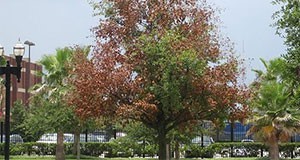Abstract
This 6-page fact sheet describes the emergence of these two pathogens of oak and grapevine in North America and Florida; the signs and symptoms of infection; mechanism of host disease and death; fungal morphology; origin, host range, and classification; and management options. Written by Sonja Mullerin and Jason A. Smith, and published by the UF Department of School of Forest Resources and Conservation, March 2015. (Photo: Jason Smith, UF/IFAS)
References
Alves, A., A. Correia, J. Luque, and A. Phillips. 2004. Botryosphaeria corticola, sp. nov. on Quercus species, with notes and description of Botryosphaeria stevensii and its anamorph, Diplodia mutila. Mycologia 96(3), 598-613. https://doi.org/10.1080/15572536.2005.11832956
Andolfi, A., L. Maddau, S. Basso, B.T. Linaldeddu, A. Cimmino, B. Scanu, A. Deidda, A. Tuzi, and A. Evidente. 2014. Diplopimarane, a 20-nor-ent-Pimarane produced by the oak pathogen Diplodia quercivora. J. Nat. Prod. 77(11), 2352-60. https://doi.org/10.1021/np500258r
Bush, E.A. Botryosphaeria canker and dieback of trees and shrubs in the landscape. 2009. Virginia Cooperative Extension Report 450-726. http://pubs.ext.vt.edu/450/450-726/450-726.html.
Campanile, G., A. Ruscelli, and N. Luisi. 2007. Antagonistic activity of endophytic fungi towards Diplodia corticola assessed by in vitro and in planta tests. Eur. J. Plant Pathol. 117, 237-46. https://doi.org/10.1007/s10658-006-9089-1
Candolfi-Arballo, O., C. Valenzuela-Solano, W. D. Gubler., and R. Hernandez-Martinez. 2010. Botryosphaeriaceae species associated with grapevine decline in Mexico. Phytopathologia Mediterranea 49, 105-06.
Djoukeng, J. D., S. Polli, P. Larignon, and E. Abou-Mansour. 2009. Identification of phytotoxins from Botrysphaeria obtusa, a pathogen of black dead arm disease of grapevine. European Journal of Plant Pathology 124, 303-08. https://doi.org/10.1007/s10658-008-9419-6
Dreaden, T. J., K. Shin, and J. A. Smith. 2011. First report of Diplodia corticola causing branch cankers on live oak (Quercus virginiana) in Florida. Plant Disease 95(8), 1027 (Aug. 2011). https://doi.org/10.1094/PDIS-02-11-0123
Dreaden, T. J., A. W. Black, S. Mullerin, and J. A. Smith. 2013. First report of Diplodia quercivora causing shoot dieback and branch cankers on live oak (Quercus virginiana) in the USA. Plant Disease (First Look), http://dx.doi.org/10.1094/PDIS-07-13-0736-PDN https://doi.org/10.1094/PDIS-07-13-0736-PDN
Lallemand, B., M. Masi, L. Maddau, M. De Lorenzi, R. Damd, A. Cimmino, Y. Moreno, L. Banuls, A. Andolfi, R. Kiss, V. Mathieu, Evidente A. 2012. Evaluation of in vitro anticancer activity of sphaeropsidins A-C, fungal rearranged pimarane diterpenes, and semisynthetic derivatives. Phytochemistry Letters 5(4), 770-75. https://doi.org/10.1016/j.phytol.2012.08.011
Linaldeddu, B. T., Franceschini, A., Alves, A., and Phillips, A. J. L. 2013. Diplodia quercivora: a new oak pathogen. Mycologia 105(5), 1266-74. https://doi.org/10.3852/12-370
Linaldeddu, B. T., C. Sirca, D. Spano, and A. Franceschini. 2009. Physiological responses of cork oak and holm oak to infection by fungal pathogens involved in oak decline. Forest Pathology 39, 232-38. https://doi.org/10.1111/j.1439-0329.2008.00579.x
Luque, J., M. Cohen, R. Save, C. Biel, and I. F. Alvarez. 1999. Effects of three fungal pathogens on water relations, chlorophyll fluorescence and growth of Quercus suber L. Annals of Forest Science 56: 19-26. https://doi.org/10.1051/forest:19990103
Luque, J., and J. Girbal. 1989. Dieback of cork oak (Quercus suber) in Catalonia (NE Spain) caused by Botryosphaeria stevensii. European Journal of Forest Pathology 19, 7-13. https://doi.org/10.1111/j.1439-0329.1989.tb00764.x
Luque, J., J. Pera, and J. Parlade. 2008. Evaluation of fungicides for the control of Botryosphaeria corticola on cork oak in Catalonia (NE Spain). Forest Pathology 38, 147-55. https://doi.org/10.1111/j.1439-0329.2007.00526.x
Lynch, S. C., A. Eskalen, P. J. Zambino, J. S. Mayorquin, and D. H. Wang. 2013. Identification and pathogenicity of Botryosphaeriaceae species associated with coast live oak (Quercus agrifolia) decline in southern California. Mycologia 105(1), 125-40. https://doi.org/10.3852/12-047
Lynch, S. C., A. Eskalen, P. Zambino, and T. Scott. 2010. First report of Bot Canker caused by Diplodia corticola on coast live oak (Quercus agrifolia) in California. Plant Disease 94(12), 1510. https://doi.org/10.1094/PDIS-04-10-0266
Maddau, L., E. Spanu, B. T. Linaldeddu, A. Franceschini, and A. Evidente. 2008. Phytotoxic metabolites produced by fungi involved in cork oak decline. SardiniaChem 2008. Giornato di Studio Dedicata Alla Chimica Organica Delle Molecole Biologicamente Attive, 30 Maggio 2008, at 70-71.
Maddau, L., A. Cabras, A. Franceschini, B. T. Linaldeddu, S. Crobu, T. Roggio, and D. Pagnozzi. 2009. Occurrence and characterization of peptaibols from Trichoderma citrinoviride, an endophytic fungus of cork oak, using electrospray ionization quadrupole time-of-flight mass spectroscopy. Microbiology 155, 3371-81. https://doi.org/10.1099/mic.0.030916-0
McPherson, B. A., N. Erbilgin, P. Bonello, and D. L. Wood. 2013. Fungal species assemblages associated with Phytophthora ramorum-infected coast live oaks following bark and ambrosia beetle colonization in northern California. Forest Ecology and Management 291, 30-42. https://doi.org/10.1016/j.foreco.2012.11.010
Mullerin, S., A. Black, J. Smith, T. Dreaden. A host range study of Diplodia corticola and Diplodia quercivora, pathogens on oak. Plant Disease (in press).
Pitt, W. M., M. R. Sosnowski, R. Huang, Y. Qiu, C. C. Steel, and S. Savocchia. 2012. Evaluation of fungicides for the management of Botryosphaeria canker of grapevine. Plant Disease 96(9), 1303-08. https://doi.org/10.1094/PDIS-11-11-0998-RE
Sinclair, W. A., H. H. Lyon, and W. T. Johnson. 2005. Diseases of Trees and Shrubs (2d ed.). Cornell University Press: Ithaca, NY, p. 124.
Slippers, B., E. Boissin, A.J.L. Phillips, J.Z. Groenewald, L. Lombard, M.J. Wingfield, A. Postma, T. Burgess, and P.W. Crous. 2013. Phylogenetic linkages in the Botryosphaeriales: a systematic and evolutionary framework. Studies in Mycology 76: 31-49. https://doi.org/10.3114/sim0020
Urbez-Torres, J. R. 2011. The status of Botryosphaeriaceae species infecting grapevines. Phytopathol. Mediterr. 50 (Supp.), S5-S45.
Urbez-Torres, J.R., M. Battany, L. J. Bettiga, C. Gispert, G. McGourty, J. Roncoroni, R. J. Smith, P. Verdegaal, and W. D. Gubler. 2010a. Botryosphaeriaceae species spore-trapping studies in California vineyards. Plant Disease 94(6), 717-24. https://doi.org/10.1094/PDIS-94-6-0717
Urbez-Torres, J. R.; F. Peduto; S. Rooney-Latham; and W. D. Gubler. 2010b. First report of Diplodia corticola causing grapevine (Vitis vinifera) cankers and trunk cankers and dieback of canyon live oak (Quercus chrysolepis) in California. Plant Disease 94 (6), 785. https://doi.org/10.1094/PDIS-94-6-0785A
Vajna, L. 1986. Branch canker and dieback of sessile oak (Q. petraea) in Hungary caused by Diplodia mutila. I. Identification of pathogen. Eur. J. For. Path. 16, 223-29.
Venkatasubbaiah, P., T. B. Sutton, and W. S. Chilton. 1991. Effect of phytotoxins produced by Botryosphaeria obtusa, the cause of black rot of apple fruit and frogeye leaf spot. Phytopathology 81: 3, 243-47. https://doi.org/10.1094/Phyto-81-243

